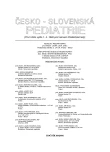-
Medical journals
- Career
Influence of Exposure to Passive Smoking after the Birth on Health Status of Children in Suckling and Toddler’s Ages. Results of ELSPAC Study
Authors: L. Kukla 1; D. Hrubá 2; M. Tyrlík 3
Authors‘ workplace: Oddělení preventivní a sociální pediatrie Ústavu sociálního lékařství a veřejného zdravotnictví LF MU, Brno vedoucí prof. MUDr. J. Holčík, DrSc. 1; Ústav preventivního lékařství LF MU, Brno vedoucí prof. MUDr. Z. Brázdová, DrSc. 2; Psychologický ústav FF MU, Brno vedoucí prof. PhDr. M. Svoboda, CSc. 3
Published in: Čes-slov Pediat 2005; 60 (2): 62-69.
Category: Original Papers
Overview
Results of number of epidemiologic studies show, that exposure to passive smoking is leading to many kinds of damages for respiratory system and their complications, especially in children. Exposure of children to passive smoking in the period of fetal development and after the birth is probably the most frequent source of contacts of this population with chemical toxic substances. In prospective longitudinal study ELSPAC, authors have analysed the data about children and their life conditions in 18 months after birth. Anamnestic data about health status of 3495 children were obtained from their mothers and paediatricians: in 139 (4.0%) children, the exposure to cigarette smoke was assessed as middle to heavy (they spent more than three hours daily in smoky space), in another 578 children (16.5 %) as minor (they spent less than three hours daily in smoky space). Most of children (2778 = 79.5 %) were not exposed to cigarette smoke after the birth at all. In these groups of children, frequency of occurence of some selected pathologic symptoms and diseases and some another factors, were assessed. Differences between groups were assessed by Pearson chi-square and ANOVA programme.
Significant differences between groups of children with different postnatal exposure to cigarette smoke showed in frequency of symptoms and diseases of respiratory system and their complications. Strong cold and coughing (73% non-exposed, 85% exposed) occured most often. In average, two thirds of this disease were treated by paediatricians. Lighter forms of caughing, lasting however several days, were given in case of two thirds of children, more often in those exposed – they also experienced significantly more episodes between 6th and 18th months of their lives. In the documentation of paediatricians, twice higher occurence of otitis in exposed children (16%) is dominating. Mothers of exposed children observed more often cases of noticeable snoring and apnoea in sleep: the age of the first episodes of apnoea was significantly lower in children who were exposed to cigarette smoke in middle and heavy way. Consumption of different medicaments in the period between 6th and 18th months of life is high in all observed groups. Treatment of symptoms and diseases of respiratory system is significantly more frequent in groups of exposed children. Almost one third of all children were daily given some medicaments during the last three months. In their number are, however, given also vitamins. Demands of children with different exposure to passive smoking on preventive and curative care did not differ statistically much, also the frequency of hospitalisations was only slightly higher in case of exposed children. It is possible to say that mothers do not take into consideration the risk of health damage due to exposure of children to passive smoking: only some 14% of mothers from middle and heavy group admitted, that this exposure could be a reason of their child’s diseases.Key words:
children, passive smoking, respiratory diseases, medical care
Labels
Neonatology Paediatrics General practitioner for children and adolescents
Article was published inCzech-Slovak Pediatrics

2005 Issue 2-
All articles in this issue
- Non-drug Poisoning in Children Hospitalized in Children Faculty Hospital in Bratislava in the Years 1996–2000
- Diarrhea Diseases in Hospitalized Children up to 5 Years of Age
- Influence of Exposure to Passive Smoking after the Birth on Health Status of Children in Suckling and Toddler’s Ages. Results of ELSPAC Study
- Prenatal Exposure to Cigarette Smoke and Behaviour of Children in 18 Months of Age. Results of ELSPAC Study
- Mannose-binding Lectin Deficiency
- Czech-Slovak Pediatrics
- Journal archive
- Current issue
- Online only
- About the journal
Most read in this issue- Mannose-binding Lectin Deficiency
- Diarrhea Diseases in Hospitalized Children up to 5 Years of Age
- Non-drug Poisoning in Children Hospitalized in Children Faculty Hospital in Bratislava in the Years 1996–2000
- Prenatal Exposure to Cigarette Smoke and Behaviour of Children in 18 Months of Age. Results of ELSPAC Study
Login#ADS_BOTTOM_SCRIPTS#Forgotten passwordEnter the email address that you registered with. We will send you instructions on how to set a new password.
- Career

